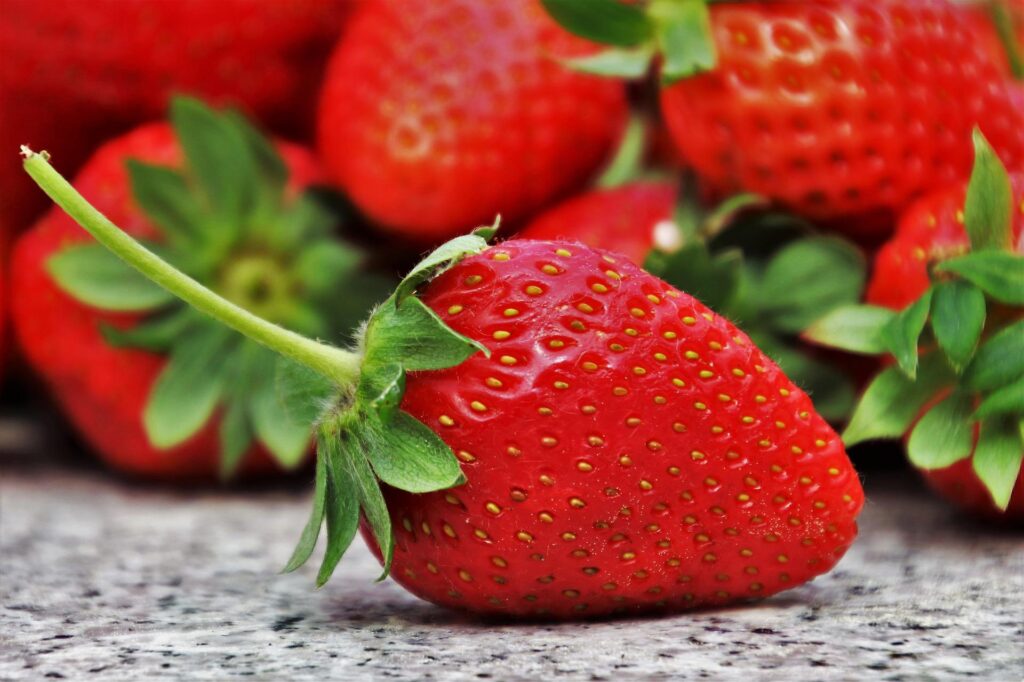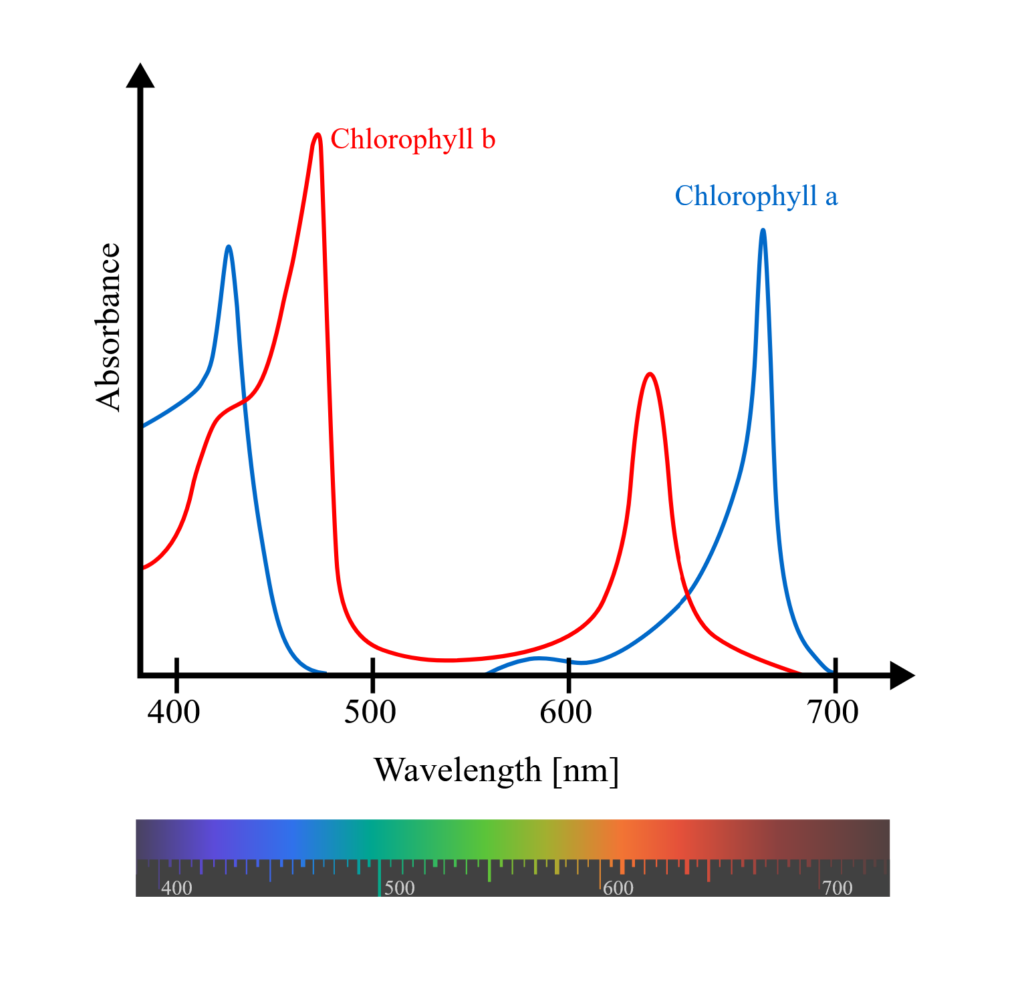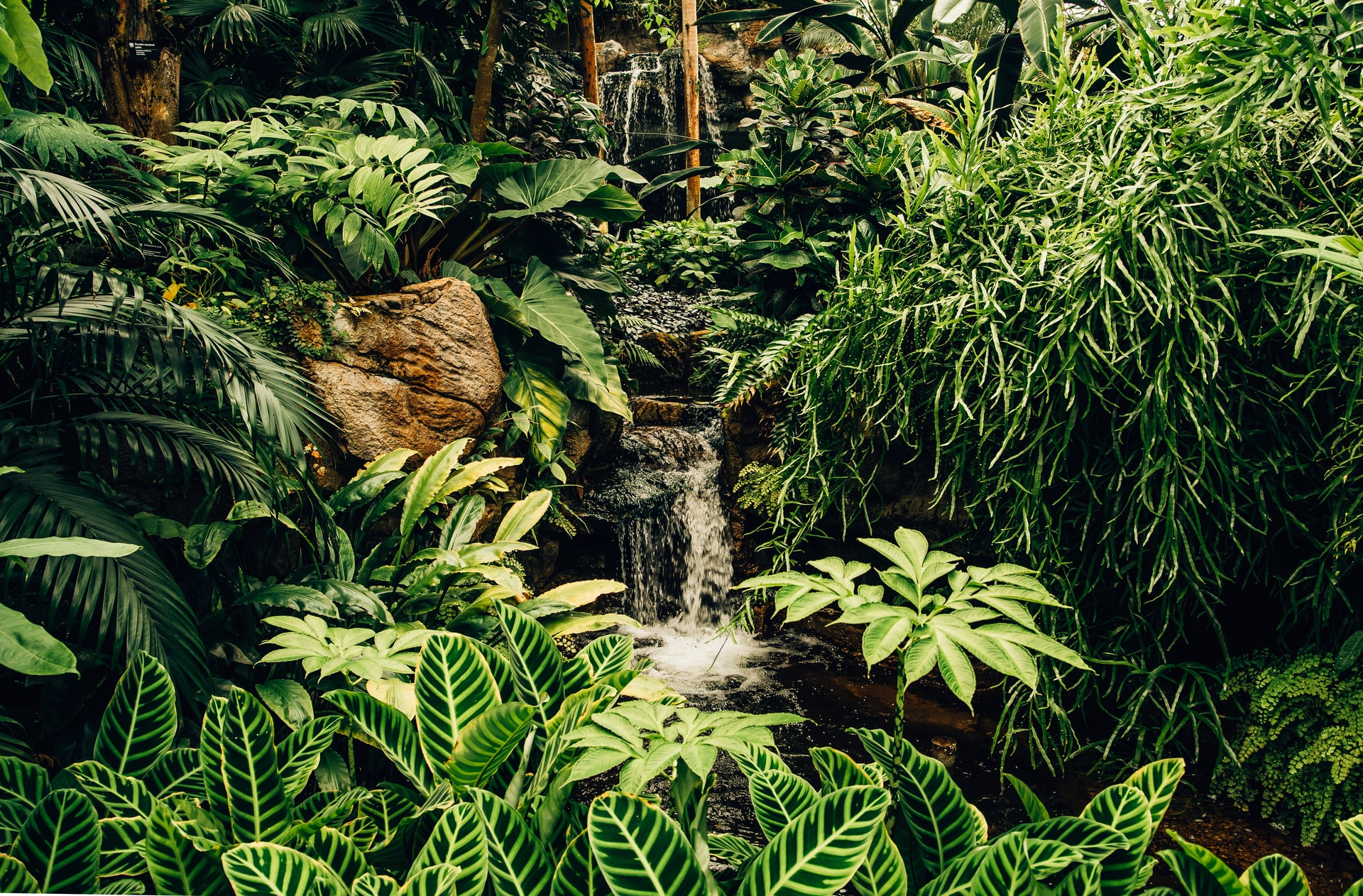Plants appear green because they contain chlorophyll, which is a green pigment. Chlorophyll absorbs most parts of visible light, but it does not absorb the parts we see as green. These are reflected by the plant and can be detected by our eyes. The reason why most plants are specifically green (rather than black) is unresolved, but it may be a safety adaptation.
Wherever you are in the world, chances are you won’t be very far from a living green plant. Despite their massive diversity, most plants on Earth are green.
The reason for this is because of how plants get their food. It’s a fairly common misconception that plants eat soil. Instead, they make their own food using ingredients from their environment. Plants combine carbon dioxide from the air and water from the soil to make sugars. This process is called photosynthesis, and it isn’t free – it takes energy, which comes from the Sun. The sugars made during photosynthesis are used as an energy source by the plant, which is rather similar to how you use the sugar in a donut. The plant also uses the sugars as building blocks to make all of its tissues.
Photosynthesis happens inside plant cells. I’m going to assume that you’re happy with living things being made of cells, but if not, you could spend a few minutes on it here, here or here. The part of a plant cell that carries out photosynthesis is called a chloroplast. Chloroplasts are curious structures that contain something called chlorophyll, which has a strong green colour. This causes any cell that contains chloroplasts to appear green. You can see chloroplasts inside a plant cell in this video, in which the chloroplasts are the things that look like green circles.
Plant cells that contain chloroplasts are mostly concentrated in the leaves. That’s because leaves also have lots of other useful features that help the plant to carry out photosynthesis, so cells containing chloroplasts are at home there.
Since we’ve now established that in plants, green means chlorophyll , we can ask a more specific question: why is chlorophyll green?
Why is chlorophyll green?
Chlorophyll’s distinctive colour is caused by its interaction with light. When something looks a certain colour to you, it means that your eyes have absorbed a particular type of light. To understand this properly, we’ll need to look at what happens when light interacts with an object.
Light travels in waves. When light waves hit an object, a few different things can happen. Light can pass through the object, such in clear materials like glass. Light can be absorbed by the object, such as in black objects like black holes. Light can also be reflected by the object, such as in shiny objects like mirrors. Often, a mixture of these things happen.
When light is partly absorbed and partly reflected, objects can appear coloured. This is because light isn’t just one type of wave. Instead, it is made of a collection of waves with different properties. A property called wavelength can help us to understand what’s going on here.
Wavelength tells us the difference between waves that are long and drawn out or short and compact. Scientifically speaking, it is the distance between the repeating parts of a wave, and we measure it in metres. The wavelengths in visible light fall inside a fairly small range, between about 400 to 700 nanometres.
At the larger end of that range, the waves are longer and more drawn out. These wavelengths belong to red light. At the smaller end of the range, the waves are shorter and more compact. These wavelengths belong to violet light.
When the different parts of visible light hit an object, some of them can be absorbed and some can be reflected. The reflected parts can travel into your eyes and be detected. Let’s take a red strawberry as an example. Strawberries appear red to you because light with a wavelength of around 700 nanometres has been reflected by the strawberry into your eyes. All of the other wavelengths of visible light have been absorbed by the strawberry, so your eyes cannot detect them.

It’s the properties of an object that determine whether particular wavelengths of light are absorbed or reflected. More specifically, coloured pigments are often responsible for the colour of an object. Pigments are chemicals that strongly absorb some parts light and reflect others. This produces a strong colour.
Chlorophyll is a type of pigment. By now, you might be able to suggest how it responds to visible light. Chlorophyll absorbs all of the visible wavelengths of light apart from the ones we see as green. This small fraction of visible light is (mostly) reflected by chlorophyll and is free to enter our eyes.
We can see this using a technique called spectroscopy. Briefly, a beam of light is directed at a bit of chlorophyll and a detector measures the light that makes it through to the other side. Light that does not make it through to the detector has been absorbed by the sample. We get results like this:

The pointy parts of the graph show light that is well absorbed by the chlorophyll sample. Notice that this broadly corresponds to two wavelength ranges: one is around 400 – 500 nm, which is essentially blue light. The other is around 600 – 700 nm, which is essentially red light. The rather large dip in the centre of the graph shows light that has been poorly absorbed, and this is essentially green light.
Note that there are two lines on the graph because there are two types of chlorophyll in green plants, types a and b. You can see from the graph that, whilst their absorbances are a bit different, both types strongly absorb red and blue wavelengths and reject green ones.
Let’s briefly return to the part about plants using energy from the Sun to make their own food through photosynthesis. This is what we’ve been looking at here in more detail. The wavelengths of sunlight that are absorbed by chlorophyll are used to power photosynthesis.
This now answers the original question: plants look green to us because they contain chlorophyll, which reflects the light we see as green into our eyes. The other parts of light are retained by chlorophyll for photosynthesis, which allows plants to make their own food.
Why aren’t plants black?
You might now be left with another question. Why do plants reject green light so strongly? Wouldn’t it be an advantage for them to capture this extra light energy for photosynthesis? If they did, plants would look black. Indeed, we can look to solar panels for an analogous technology – they also capture energy from sunlight, a bit like the human version of leaves. And they’re black. So, perhaps we should be asking why plants aren’t black.
There’s no established answer to this question. However, scientists have suggested some possible reasons. One of these is that plants aren’t just trying to absorb as much energy as possible, but rather, as much energy as safely as possible. Plants are vulnerable to damage from too much sunlight, and it’s already known that they have several adaptations to protect themselves.
A team of scientists have recently suggested that selectively absorbing red and blue light may be an adaptation to protect against fluctuations in the amount of light that hits leaves. They suggest that sudden changes in light intensity might damage leaves, much like a power surge to an electrical appliance. By restricting the absorption of light to narrow and separated wavelength bands, the scientists showed that fluctuations in light intensity can be smoothed and therefore safely handled. The original research was published in the distinguished journal Science, and can also be found open-access here.

